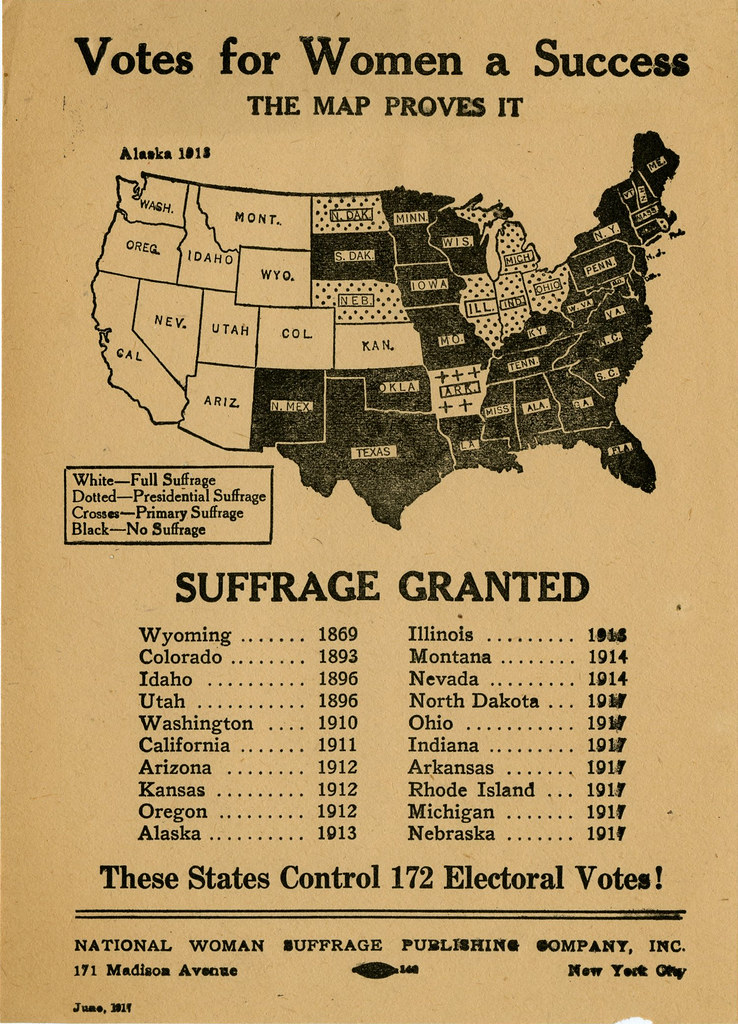Story
Which State Had Women’s Suffrage First?
A Timeline of Voting Rights in the United States
This year, many are celebrating the centennial of the passage of the 19th Amendment to the U.S. Constitution, which extended suffrage by preventing states from denying citizens the right to vote on the basis of sex. This was a historic day in both United States history and women’s history, and is something worth celebrating. It was the culmination of decades of hard work and struggle for suffragists across the nation, from New York to California, from Colorado to Washington D.C. itself.
But the 1920 election was not the first time that women voted in the United States. Not by a long shot.
For many, many years, the laws dictating who could vote in both local and national elections were not decided on the federal level. Instead, it varied significantly between states and territories—and many had given women the right to vote long before it was realized on a national scale.
So which state granted women suffrage first?
The answer seems like it should be clear cut, but like most things in United States history, it is much more complicated than you might expect. There is a great deal of nuance and semantics, and several different states can claim to be the first.
Chronologically, the first state in the union in which women voted was New Jersey. The original 1776 New Jersey State Constitution provided suffrage to its citizens without mentioning gender or race—the only requirements were that they be “inhabits of this State” who were “of full age” and “worth fifty pounds proclamation money.” That is, all adults who owned at least fifty pounds worth of property were eligible to vote. This was later reinforced by a much more explicit ruling by the state’s supreme court in the 1790s, which made it clear that women held the vote in New Jersey.
This still excluded large portions of the population. Fifty pounds was quite a lot of money in the 18th century, after all, and among women of the time typically only widows owned property. But the fact that wealthy women and free non-whites were able to vote in New Jersey made it unique among the original thirteen states of the union.
Unfortunately, New Jersey’s claim to the title of First State to Grant Suffrage is muddled by the fact that this equality did not last for more than thirty years. By 1807, the state legislature amended their constitution to restrict the vote to tax-paying white male citizens. The reason why is debated, but may have been tied to the complex party politics of the time.
The next opportunity for equal suffrage between the genders didn’t come until several decades later. In 1867, Kansas became the first state to hold a referendum on the question of women’s suffrage. The suggestion was voted down by an overwhelming majority, but of course the fight didn’t end there. It just moved further west.

Early suffragists like Minnie Reynolds Scalabrino championed women’s voting rights in their home states; many of them went on to fight for suffrage on a national level.
The first place in the United States to enfranchise women after New Jersey was the Wyoming Territory, which passed women’s suffrage on December 10, 1869—an event which has been commemorated as Wyoming Day in the state ever since.
However, Wyoming was not the first territory where women voted. That distinction goes to the Utah Territory, which had enfranchised women only a few months later, on February 12, 1870. This bill was notably passed through the Utah Territorial Legislature by a unanimous vote. Elections in Utah were held earlier in the year than in Wyoming, so by pure luck Utah women got to practice their newly earned right first. Seraph Young, the niece of then Latter-Day Saints church president Brigham Young, was the first woman to vote in the nation since 1807.
But much like the situation half a century earlier in New Jersey, it was not to last. The Edmunds-Tucker Act of 1887 repealed women’s suffrage in the Utah territory, as part of efforts by the federal government to combat polygamy and the power of the Church of Latter-Day Saints. Voting rights would not be restored to Utahn women until 1896, when the territory gained statehood and wrote equal suffrage into its constitution.
Suffrage in Wyoming, at least, was here to stay. It was never repealed, and Wyoming women have held the vote continuously for longer than anywhere else in the United States. But was Wyoming the first state to grant suffrage? It’s slightly complicated.
Wyoming was a territory at the time of the 1869 act which granted its women suffrage. This gives neighboring state Colorado a possible claim to the title. Colorado held a referendum on November 7, 1893 on the subject of women’s suffrage. The proposed amendment was passed, making it the first time in U.S. history that a popular vote passed women’s suffrage into law (as opposed to an executive order or a legislative amendment), and the first time in U.S. history that a state granted women’s suffrage while being a state. However, by this point Wyoming had already been a state for more than three years.
So the answer to the question is not as easy as it may seem. Four current states—New Jersey, Wyoming, Utah, and Colorado—can claim for various reasons to be the first state to grant women’s suffrage. And really, the answer depends on how exactly one asks the question; what is meant by “state”; and whether or not later rescinding that right disqualifies anyone.

This flyer was used by suffragists in 1919 to help gain support for the Nineteenth Amendment. The map it depicts shows the different levels of suffrage held by women in different states.
But at the end of the day, none of that is as important as what was achieved. The struggle for women’s suffrage was one that transcended territorial boundaries and state lines. It covered entire generations, and lasted all the way from the American Revolution, through the entire 19th century, and right up until the Roaring Twenties. It was not a competition. It was a unifying struggle that brought women, and men, from all across the nation together.
Several other states granted women the vote before it reached the federal level. First came Idaho, in 1896. In 1910, Washington women voted for the first time. This was quickly followed in 1911 by California. In 1912, Arizona, Kansas, and the Alaska Territory all granted women suffrage. Illinois women were granted suffrage in 1913, and the next year Nevada and Montana followed. By 1919, nine more states (Arkansas, Indiana, Michigan, Nebraska, New York, Ohio, Oklahoma, Rhode Island, and South Dakota) had granted partial or full suffrage to female citizens.
Each of these states and territories represents another victory on the long road to full suffrage. Each one was the result of thousands of individuals working and struggling together, through protests and marches, demonstrations and conventions, and even political campaigns. This year, for the hundredth anniversary of the passing of the Nineteenth Amendment, our goal isn’t just to celebrate the final victory. We want to celebrate each and every step along the way.
